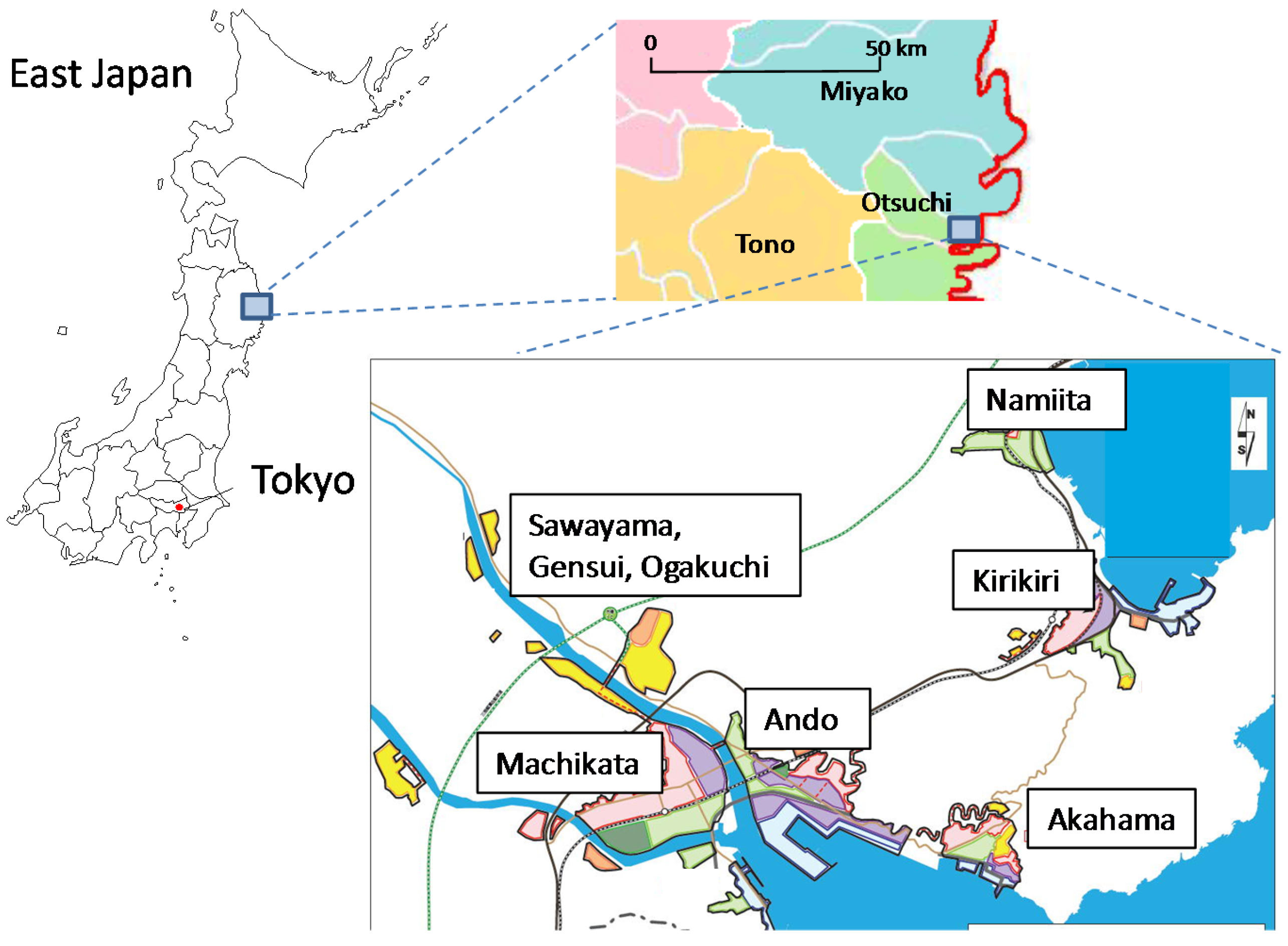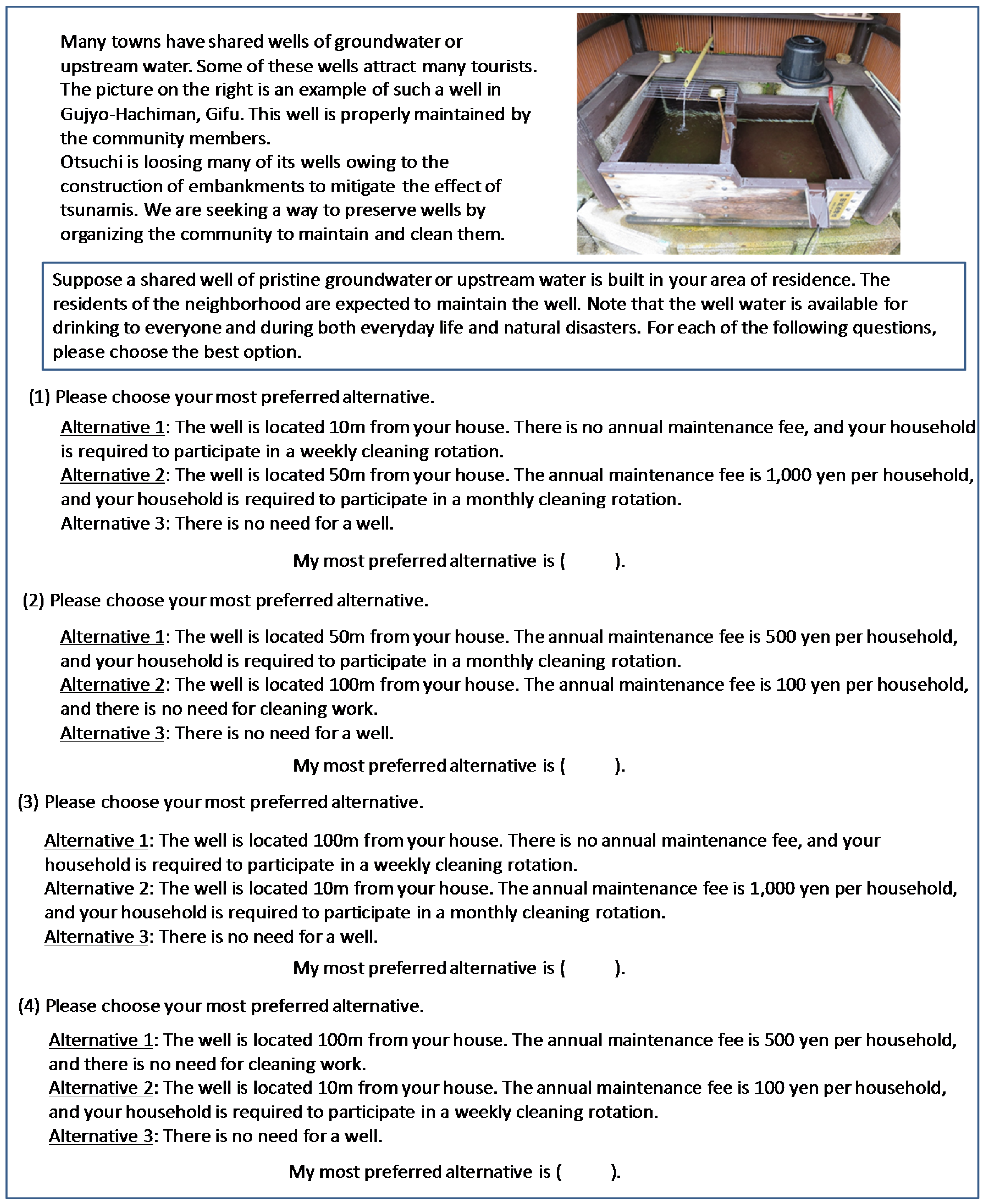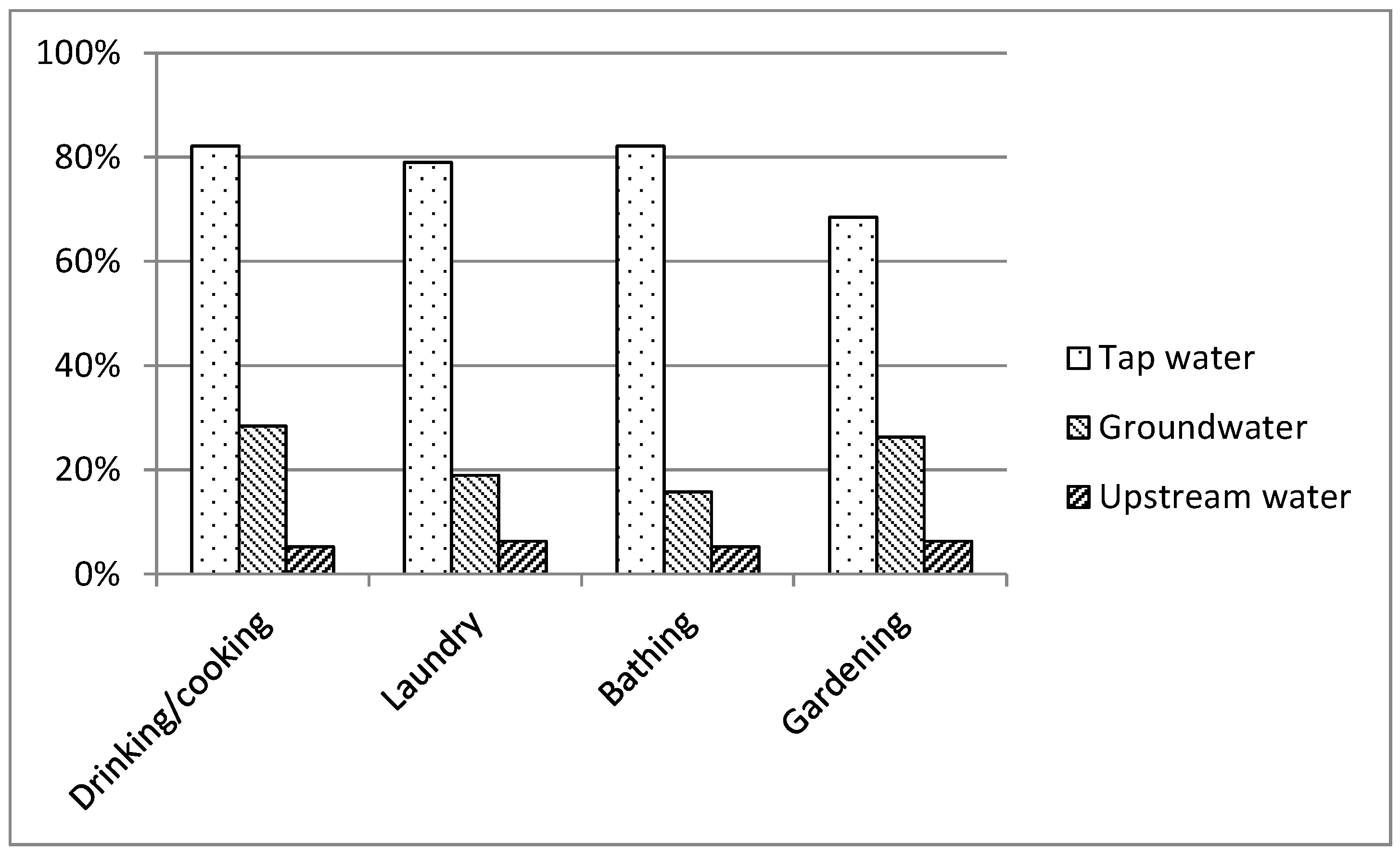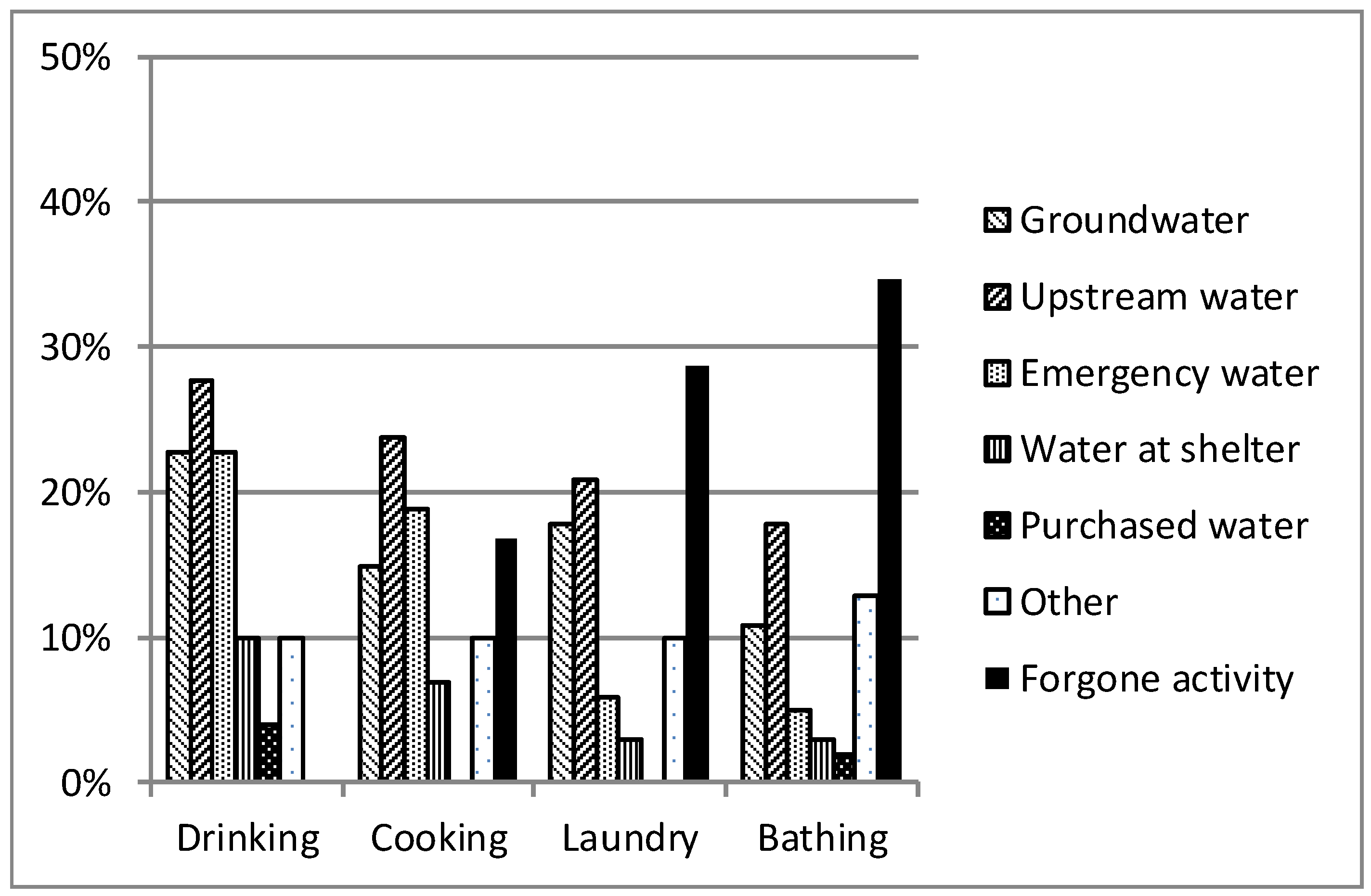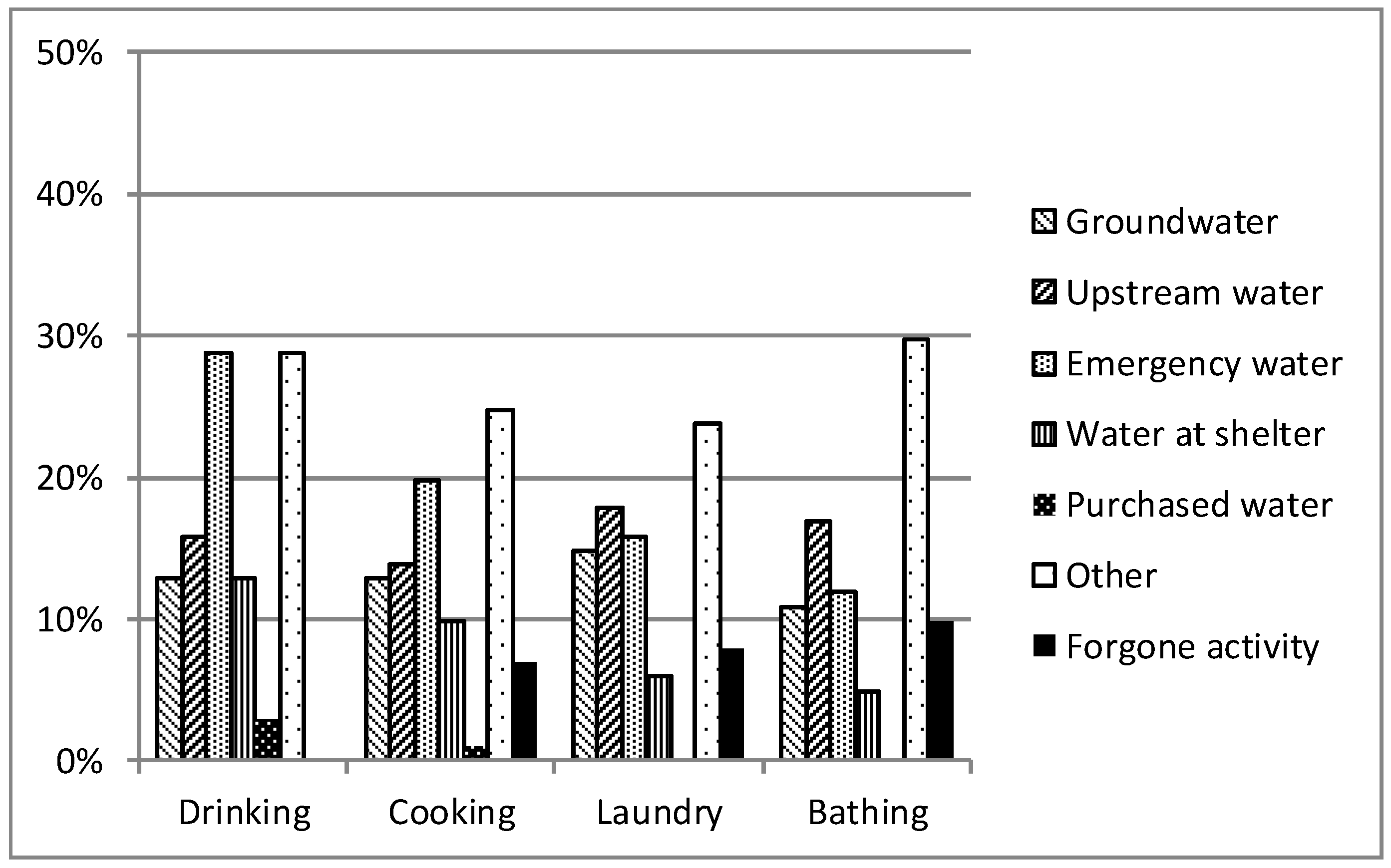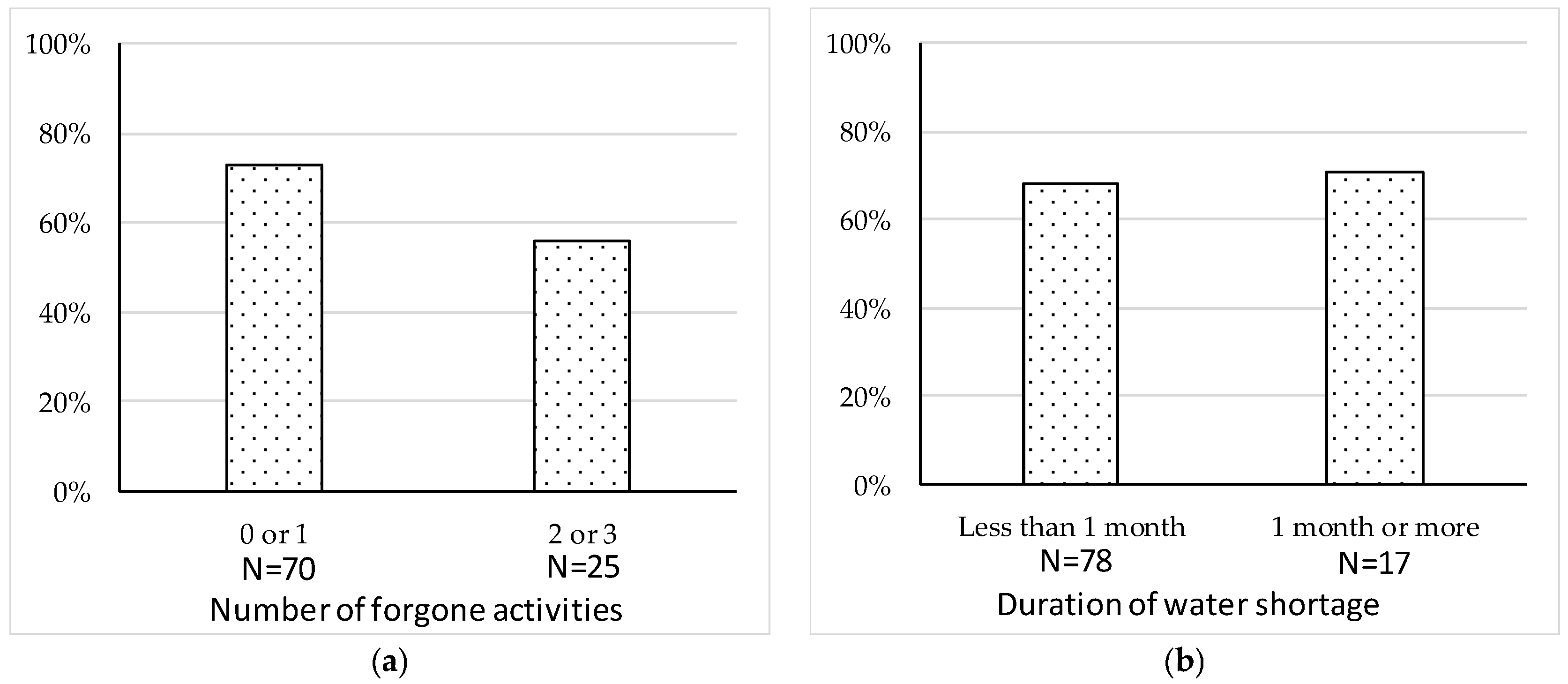2.1. Analytical Framework and Indices of Water Shortage
Research on factors affecting people’s perception and behavior regarding water management employ two frameworks. One group uses psychological models that often adopt a multi-level structure to consider both the direct and indirect factors influencing perception and behavior [
9,
10]. The other group implements environmental economics approaches and focuses on factors directly affecting choice situations regarding water-management policies. Among these methods, a choice experiment (CE) can explicitly consider various attributes of water-management policies, including hypothetical ones, and characteristics of an individual who makes necessary choices. This study employs a CE approach because it focuses on the direct impact of water-shortage experiences on the choice of different configurations of community-well management schemes that were yet to be realized. Within the water-management literature, CE has often been applied to the evaluation of improvements in the water quality of rivers and lakes because such investigations require the comparisons of various water-quality situations, including those hypothetically defined [
15,
16]. Hensher et al. [
17] conducted a CE in Canberra, Australia, and analyzed households’ responses to avoid water restrictions caused by a drought. CE has also been used in disaster-recovery studies [
18]. This study demonstrates a new example of CE application to the examination of alternative water resources following a large-scale disaster.
Two indicators were designed to measure the levels of unavailability and inaccessibility of water during the five weeks after the tsunami: water usage forgone, and duration of water shortage. Water usage forgone is measured as the maximum number of activities including cooking, laundry, and bathing that the respondent had to give up during the five weeks. As will be shown later, the highest number of forgone activities was reported for the first week after the tsunami, when the number of evacuees peaked at more than 7400 [
19]. On 11 March 2011, the tap-water network ceased to operate because of the power outage and damage to water-supply facilities caused by the tsunami. According to the report by one of the largest evacuation shelters in Otsuchi, an organized supply of emergency water was initiated on 16 March 2011 [
20]. Thus, it is highly likely that the respondents were unable to perform a large number of water-consuming activities during the first week because of the overall unavailability of water in their area. The duration of the water shortage is measured as the number of weeks during which the respondents were unable to use water for cooking, laundry or bathing. A longer duration of water shortage for a household is assumed to be a problem of individual accessibility to the water system. For example, given that temporary bathing facilities were made available in the area within two weeks after the tsunami [
21], insufficient water to bathe even five weeks later was likely due to the transportation problem and not a water shortage.
2.2. Survey
A mall-intercept survey was conducted at the Mast Shopping Center, Otsuchi, during 17–19 August 2015. The survey was administered under the difficult conditions of the aftermath of the large disaster. Given the temporary relocation of numerous tsunami-affected households, random sampling of citizens from the town’s official resident list was not possible. Following a comparison of the mall-intercept and area-sampling methods, the former was employed. This was done particularly because of the town hall officials’ request to avoid additional disturbances to the survivors through house visits. The shopping center hosts the largest supermarket in the town and various other shops. It serves as the hub of the local bus network to enable residents who do not have a car to come here for everyday shopping. Thus, this is an appropriate place to conduct a survey of a cross-section of the regional population. The number of questions asked per person was limited in order to maximize the number of passers by surveyed at the shopping center. Prior to conducting the main survey, seven local residents with different occupations were consulted about the questionnaire content to clarify questions and eliminate expressions that could distress the disaster survivors. The question regarding income was excluded during this process.
Flyers were distributed to customers at the main entrance of the shopping center, who were then asked to participate in the survey, which targeted people of high-school age or older. A total of 127 respondents participated in the survey. According to the shopping-mall manager, approximately 2500 customers, including children, visit the shopping center every day on average.
The questionnaire comprised four sections. The first section consisted of questions on water use before the 2011 tsunami and in the following five weeks. The second section asked questions about respondents’ knowledge and ideas about the diversification of water resources in Otsuchi. The third section listed four CE questions on voluntary participation in the management of a shared well. The fourth section focused on personal demographic attributes.
2.3. Choice Experiment
The CE in this study presented respondents with a hypothetical scenario of setting up a shared well. The CE section of the questionnaire specified that the shared well used either groundwater or upstream water so that all Otsuchi residents—including those living in an area without easy access to groundwater—could answer the questions. Three attributes of the well were considered: distance from respondents’ household to the well, annual fee per household for well maintenance, and frequency of each household’s rotation in well cleaning. Each attribute was further divided into levels: 10 m, 50 m, and 100 m for distance; no fee, 100 yen, 500 yen and 1000 yen for annual maintenance fee per household; and no obligation, monthly, and weekly for cleaning rotation. Each question presented three alternatives of the shared well: two were management alternatives and the remaining stated “There is no need for a well.” The clarity of the meaning and visual arrangement of these attributes and levels were verified by the seven Otsuchi residents in the pre-survey.
Figure 2 depicts the four sets of sample questions used in the questionnaire, which were translated to English for the purpose of this study.
Management alternatives comprise a combination of the aforementioned attribute levels. These combinations were produced by “the orthogonal optimal in the difference fractional factorial design” using the Ngene software package (ChoiceMetrics, Sydney, Australia). This design prevents attributes common across alternatives from assuming the same level during the experiment while maintaining orthogonality among the main effects [
22]. The design produced 36 questions. Next, questions in which a management alternative showed a shorter distance, cheaper cost, and less frequent cleaning duty than the other management alternative were eliminated. These are considered less effective questions because there are presumably no trade-offs across the attributes among such management alternatives. Subsequently, the number of questions was reduced to 28. Asking a single respondent all 28 questions could cause fatigue and inaccuracy; therefore, we divided the questions into seven groups. Each respondent was randomly presented with one of the seven groups of questions. This approach of dividing a large number of CE question into several groups (blocks) is in line with the recommendation by the literature [
23].
Figure 2 presents one of the grouped question sets.
We used two statistical models to analyze the results of the choice experiment. Given the small sample size, we first used a simple model, which does not need complex estimation procedures, to examine the outline of our research questions. Here, water-shortage experience in terms of availability and accessibility issues were considered. For this purpose, we used the alternative-specific conditional logit model. Then, we used a more flexible, but calculation-heavy mixed logit model that considered the panel structure of the dataset and unknown heterogeneity of the preferences.
Equation (1) defines the utility that respondent i (i = 1, …, I) would obtain by choosing management alternative j (j = 1, 2) at question repetition t (t = 1, …, 4).
The utility of choosing the third alternative, “No need for a well” (
Ui3t), is set as the baseline for the utility comparison of the alternatives and thus,
Ui3t does not include variables other than the error term:
x1ijt and x2ijt denote the annual maintenance fee per household and distance from the respondent’s household to the well. Since the cleaning rotation attribute has categorical levels, two dummy variables were used to describe the utility difference in relation to the “no obligation” level: x3ijt equals 1 if the alternative requires weekly participation in the well cleaning, and 0 otherwise, and x4ijt equals 1 if the alternative requires monthly participation in cleaning work, and 0 otherwise. The coefficients of the model are described by β1i through β5i. In particular, β5i denotes the utility of the state with a neighborhood shared well that requires no maintenance fees or clearing work relative to the state of having no well at all. Error term εijt is independently and identically distributed according to the Gumbel distribution.
For the simple model, all the coefficients are assumed to be same across individuals. Thus, the coefficients become β1 to β5 and take fixed values. To consider the impact of water shortage experience on the preference for the shared well, β5 is decomposed as indicated by Equation (3). Here, z2i denotes the amount of water usage forgone and z3i denotes the duration of water shortage for individual i. δ1 to δ3 are the coefficients. This model was estimated using a maximum likelihood method with an asclogit command in the Stata 13 software.
For the mixed logit model, to accommodate the unknown heterogeneity of preferences among respondents, β
1i is assumed to be log normal distributed in the population, while β
2i to β
5i has a multivariate normal distribution. These distributions were assumed to be independent of each other. This model was estimated using a simulated maximum likelihood method [
24] with a mixlogit command in the Stata 13 software.
